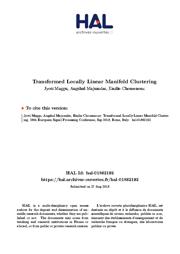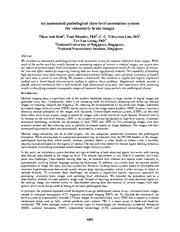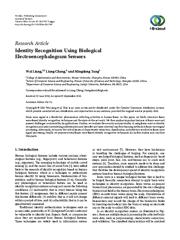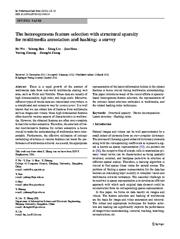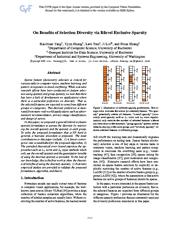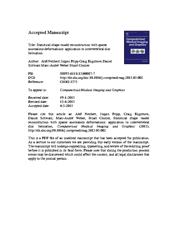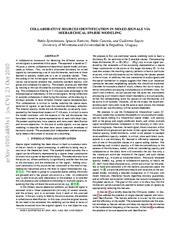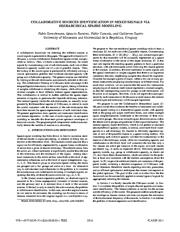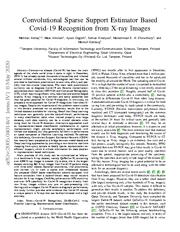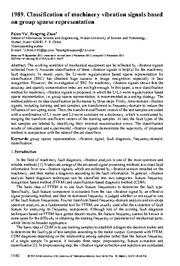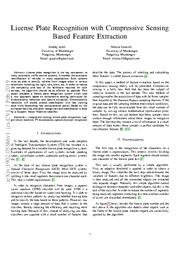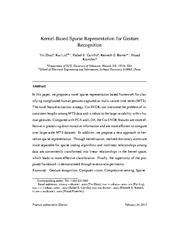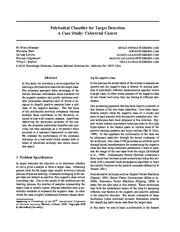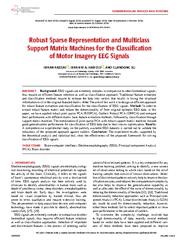A copy of this work was available on the public web and has been preserved in the Wayback Machine. The capture dates from 2019; you can also visit the original URL.
The file type is application/pdf.
Filters
Transformed Locally Linear Manifold Clustering
2018
2018 26th European Signal Processing Conference (EUSIPCO)
Transform learning is a relatively new analysis formulation for learning a basis to represent signals. ...
The core idea is to perform the clustering task in a transformed domain instead of processing directly the raw samples. ...
For our proposed method, we do not require any feature extraction technique. However, when we applied the OMP, DSC and TL-LLMC algorithms on the raw data, very poor results were obtained. ...
doi:10.23919/eusipco.2018.8553061
dblp:conf/eusipco/MagguMC18
fatcat:teg2nty5nvfevk4aqurrylmk4y
An automated pathological class level annotation system for volumetric brain images
2012
AMIA Annual Symposium Proceedings
This capability of handling high-dimensional noisy data, however, poses additional technical challenges, since statistical estimation of models for such data is prone to over-fitting. ...
While much of the earlier work has mainly focused on annotating regions of interest in medical images, our system does not require annotated region level training data nor assumes perfect segmentation ...
Part of this work was done when the first author was supported by a Singapore Millennium Fellowship. ...
pmid:23304397
pmcid:PMC3540549
fatcat:xxdgnptgzbc27h65z6y5o5z5qa
Identity Recognition Using Biological Electroencephalogram Sensors
2016
Journal of Sensors
Finally, we propose several brain wave-based identity recognition techniques for further studies and conclude this paper. ...
We then analyze important features of brain wave and present challenges confronted by its applications. ...
In this situation, samples require a procedure of high dimensional spatial feature extraction. In other words, samples will be expressed in low dimensional spaces via projections. ...
doi:10.1155/2016/1831742
fatcat:lftejeohsvd35hdw54uewwpuqa
The heterogeneous feature selection with structural sparsity for multimedia annotation and hashing: a survey
2012
International Journal of Multimedia Information Retrieval
Therefore, the selection of limited discriminative features for certain semantics is hence crucial to make the understanding of multimedia more interpretable. ...
techniques. ...
To reduce the complexity of finding the relevant samples for a query, indexing techniques are necessarily required to organize images and videos. ...
doi:10.1007/s13735-012-0001-9
fatcat:4ihorofn6zbg3mzqnifihgcydm
On Benefits of Selection Diversity via Bilevel Exclusive Sparsity
2016
2016 IEEE Conference on Computer Vision and Pattern Recognition (CVPR)
Sparse feature (dictionary) selection is critical for various tasks in computer vision, machine learning, and pattern recognition to avoid overfitting. ...
That is, the selected features are expected to come from different groups or categories. ...
Acknowledgement The authors from University of Rochester are supported by the NSF grant CNS-1548078 and the NEC fellowship. Shuai Huang is supported by NSF grant CMMI-1505260. ...
doi:10.1109/cvpr.2016.640
dblp:conf/cvpr/YangHT0H16
fatcat:dkdboutaencf5knddx5rabgkla
Anticancer Peptides Classification using Kernel Sparse Representation Classifier
[article]
2022
arXiv
pre-print
technique} (SMOTE) is used to balance the dictionary. ...
Furthermore, the \emph{kernel principal component analysis} (KPCA) is employed to cope with non-linearity and dimension reduction of the feature space whereas the \emph{synthetic minority oversampling ...
Acknowledgment The authors would like to thank Dr. Shujaat Khan for his valuable suggestions and for providing a Python implementation of his sparse representation classification toolbox. ...
arXiv:2212.10567v1
fatcat:lcvt2xu67rdzzady4r5vs25rsa
Statistical shape model reconstruction with sparse anomalous deformations: Application to intervertebral disc herniation
2015
Computerized Medical Imaging and Graphics
Abstract Many medical image processing techniques rely on accurate shape modeling of anatomical features. ...
The sparse reconstruction provided novel quantitative features describing the herniation morphology and MRI signal appearance in three dimensions (3D). ...
Acknowledgments This research was supported under Australian Research Council's Linkage Projects funding scheme LP100200422. The authors would like to thank Dr. ...
doi:10.1016/j.compmedimag.2015.05.002
pmid:26060085
fatcat:eu2nlymz4zalhoyfj2wvii4jau
Collaborative Sources Identification in Mixed Signals via Hierarchical Sparse Modeling
[article]
2010
arXiv
pre-print
samples to have different internal sparse representations. ...
that have been trained for sparse representation of each individual class. ...
For C-HiLasso, the feature extraction process needs to be linear, and extracting the SE is not a linear operation. ...
arXiv:1010.4893v1
fatcat:fixiw3go5vfp3iprgsnw2wnl44
Collaborative sources identification in mixed signals via hierarchical sparse modeling
2011
2011 IEEE International Conference on Acoustics, Speech and Signal Processing (ICASSP)
samples to have different internal sparse representations. ...
that have been trained for sparse representation of each individual class. ...
For C-HiLasso, the feature extraction process needs to be linear, and extracting the SE is not a linear operation. ...
doi:10.1109/icassp.2011.5947683
dblp:conf/icassp/SprechmannRCS11
fatcat:ybzsu7bvh5aypmkfb54znu2dsa
Convolutional Sparse Support Estimator Based Covid-19 Recognition from X-ray Images
[article]
2020
arXiv
pre-print
mapping from query sample to ideally sparse representation coefficient' support, which is critical information for class decision in representation based techniques. ...
The main tools practitioners currently use to diagnose Covid-19 are Reverse Transcription-Polymerase Chain reaction (RT-PCR) and Computed Tomography (CT), which require significant time, resources and ...
The pipeline employs the pre-trained deep neural network for feature extraction. ...
arXiv:2005.04014v1
fatcat:o4ukzhrbtjb6jc6ey5xpnsfpui
Classification of machinery vibration signals based on group sparse representation
2016
Journal of Vibroengineering
In this paper, a new classification method for machinery vibration signals is proposed, in which the L1L2-norm regularization based sparse representation, i.e. group sparse representation, is recommended ...
Firstly, time-domain vibration signals, including training and test samples, are transformed to frequency-domain to reduce the influence of corrupting noise. ...
Acknowledgements This work is partially supported by the National Natural Science Foundation of China ...
doi:10.21595/jve.2015.16459
fatcat:v6ldthtlfbfnvkg2vlhzswm4r4
License Plate Recognition with Compressive Sensing Based Feature Extraction
[article]
2019
arXiv
pre-print
This paper proposes a license plate recognition system which uses a new approach based on compressive sensing techniques for dimensionality reduction and feature extraction. ...
Based on the extracted features, character recognition and classification is done by a Support Vector Machine classifier. ...
First, the image of the license plate is converted to a black and white image. All groups of connected pixels are then extracted into separate images. ...
arXiv:1902.05386v1
fatcat:u55jlfxqfbfl5ceeh2euffvjwa
Kernel-based sparse representation for gesture recognition
2013
Pattern Recognition
The novel feature extraction strategy, CovSVDK, can overcome the problem of inconsistent lengths among MTS data and is robust to the large variability within human gestures. ...
Through kernelization, realized dictionary atoms are more separable for sparse coding algorithms and nonlinear relationships among data are conveniently transformed into linear relationships in the kernel ...
Algorithm 1 Kernelized SRC: Training Require: Training set T 1: Preprocess each training sample with median filter (optional) 2: for i = 1 to k do 3: for j = 1 to n i do 4: Feature extraction for each ...
doi:10.1016/j.patcog.2013.06.007
fatcat:kmm7nytrhjgffe6rfn72bbhq6e
Polyhedral classifier for target detection
2008
Proceedings of the 25th international conference on Machine learning - ICML '08
The flat faces of the polyhedron provides robustness whereas multiple faces contributes to the flexibility required to deal with complex datasets. ...
In this study we introduce a novel algorithm for learning a polyhedron to describe the target class. ...
Support vector domain description technique aims to fit a tight hyper-sphere in the feature space to include most of the positive training samples and reject outliers (Tax & Duin, 1999) . ...
doi:10.1145/1390156.1390193
dblp:conf/icml/DundarWLSR08
fatcat:m5iixsqefbe5za3yty4yrliw5m
Robust Sparse Representation and Multiclass Support Matrix Machines for the Classification of Motor Imagery EEG Signals
2019
IEEE Journal of Translational Engineering in Health and Medicine
The aim of this work is to design an efficient approach for robust feature extraction and classification for the classification of EEG signals. ...
Traditional feature extraction and classification methods require to reshape the data into vectors that results in losing the structural information exist in the original featured matrix. ...
whereas corresponding to a group of features to be jointly sparse [14] . ...
doi:10.1109/jtehm.2019.2942017
pmid:32309055
pmcid:PMC6822635
fatcat:qlgmqsl5affzjp7qds3zeqqw2m
« Previous
Showing results 1 — 15 out of 23,213 results

